2022届高考英语语篇填空实用拿分技巧学案(无答案)
文档属性
| 名称 | 2022届高考英语语篇填空实用拿分技巧学案(无答案) | 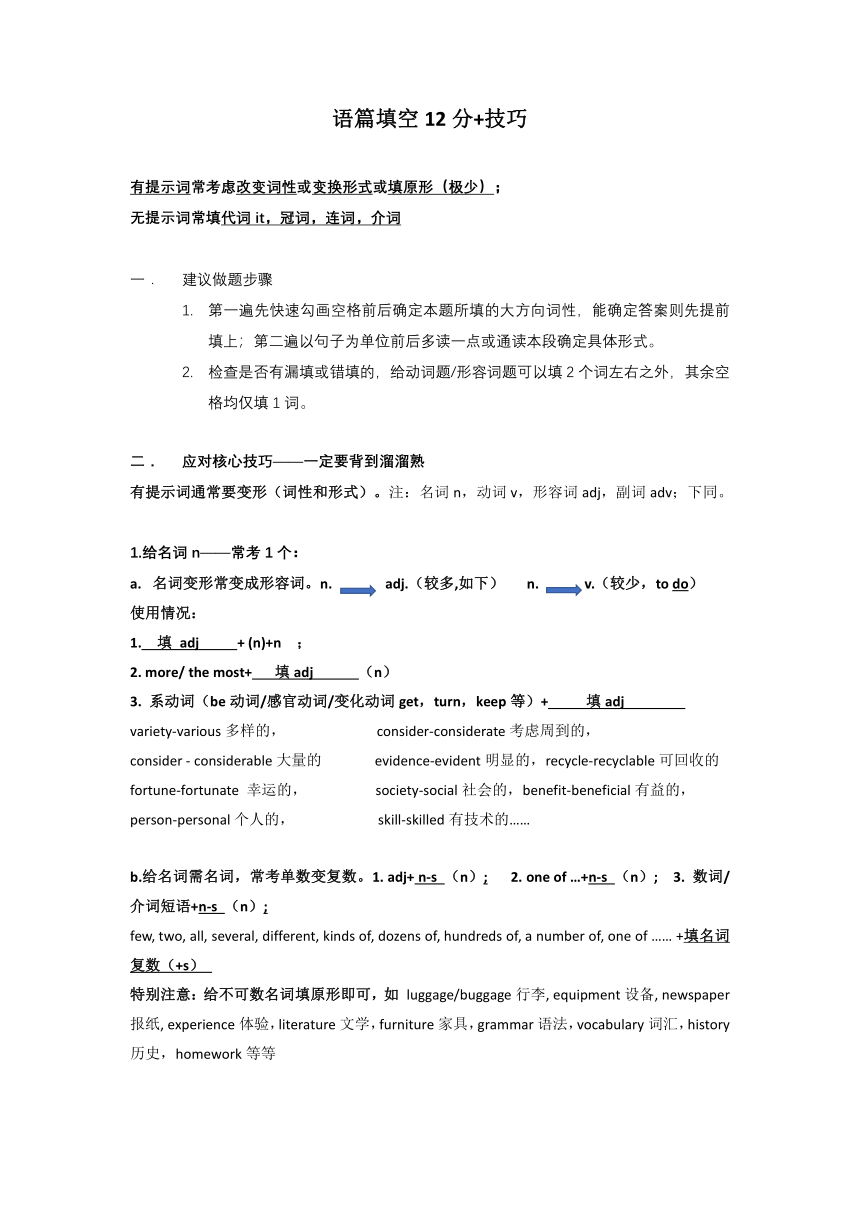 | |
| 格式 | docx | ||
| 文件大小 | 42.9KB | ||
| 资源类型 | 教案 | ||
| 版本资源 | 通用版 | ||
| 科目 | 英语 | ||
| 更新时间 | 2022-04-11 14:08:43 | ||
图片预览

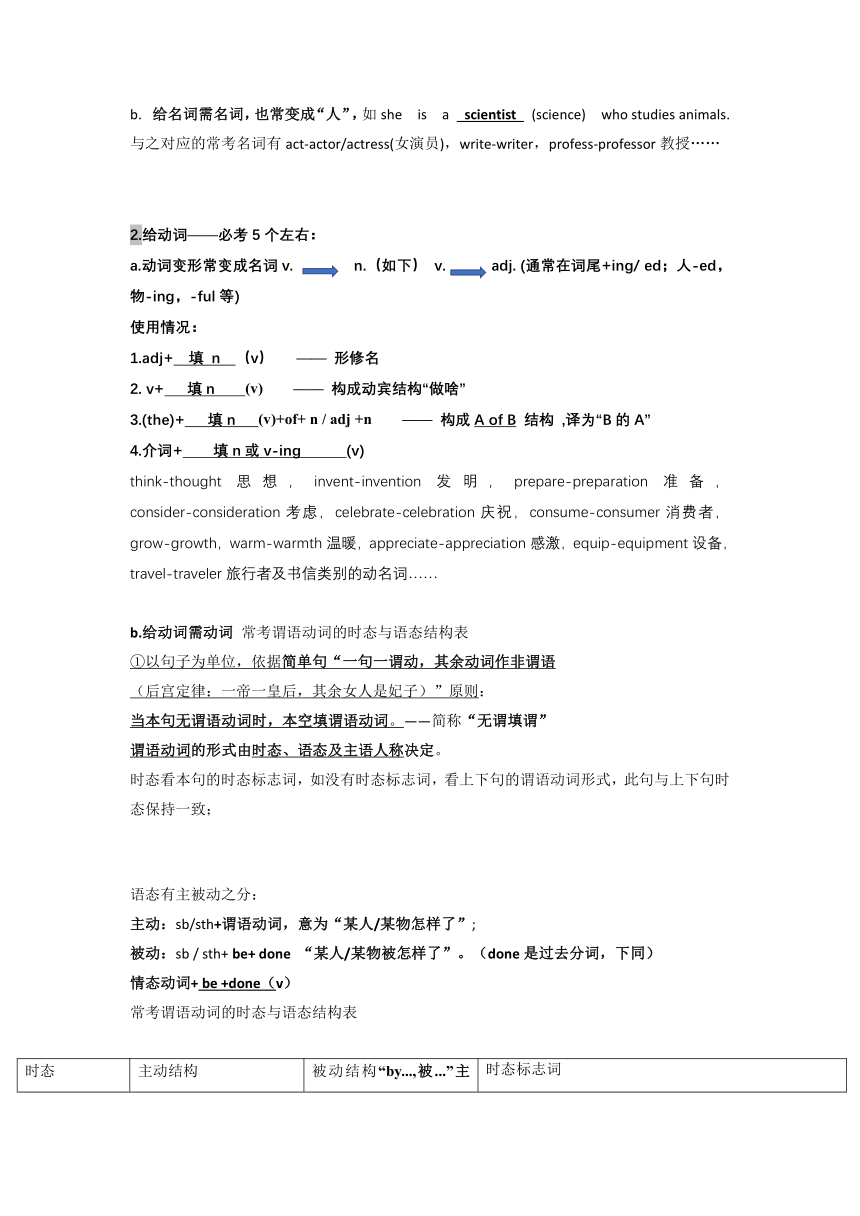
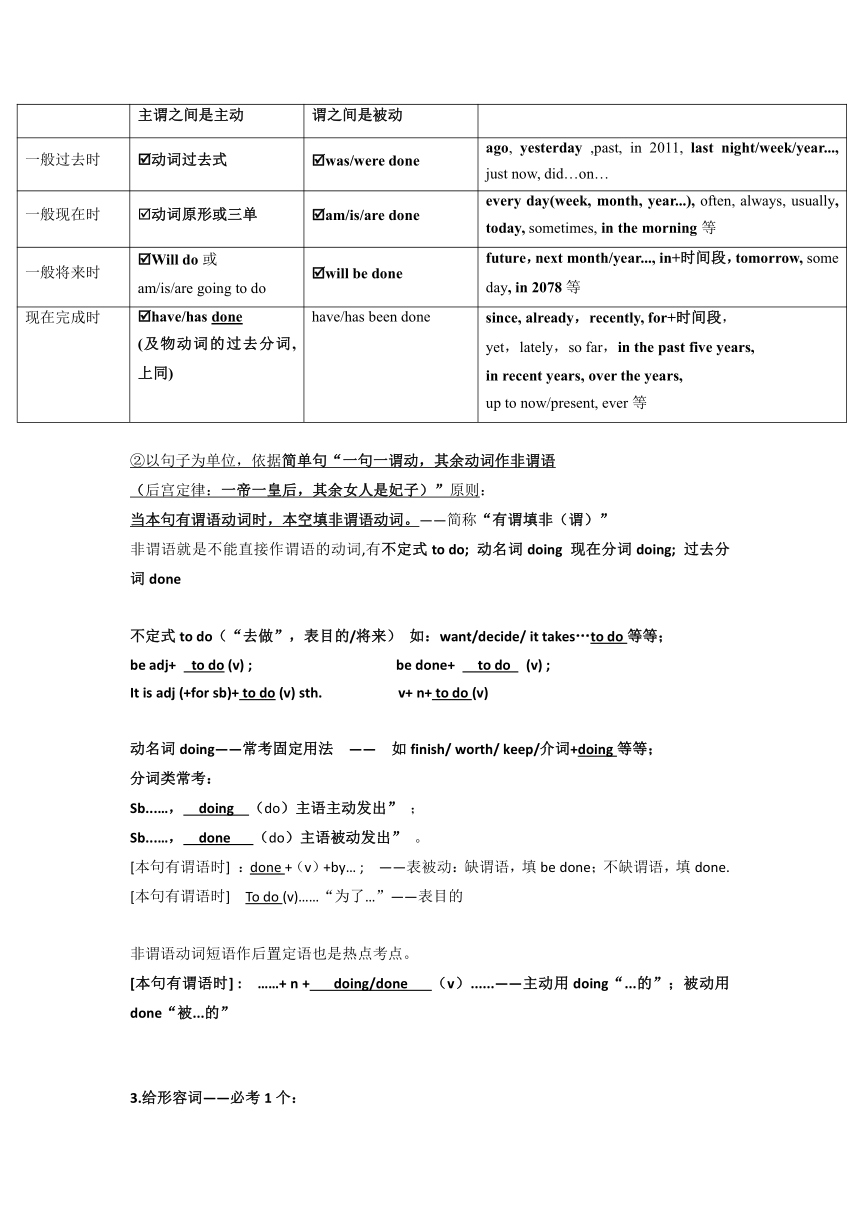
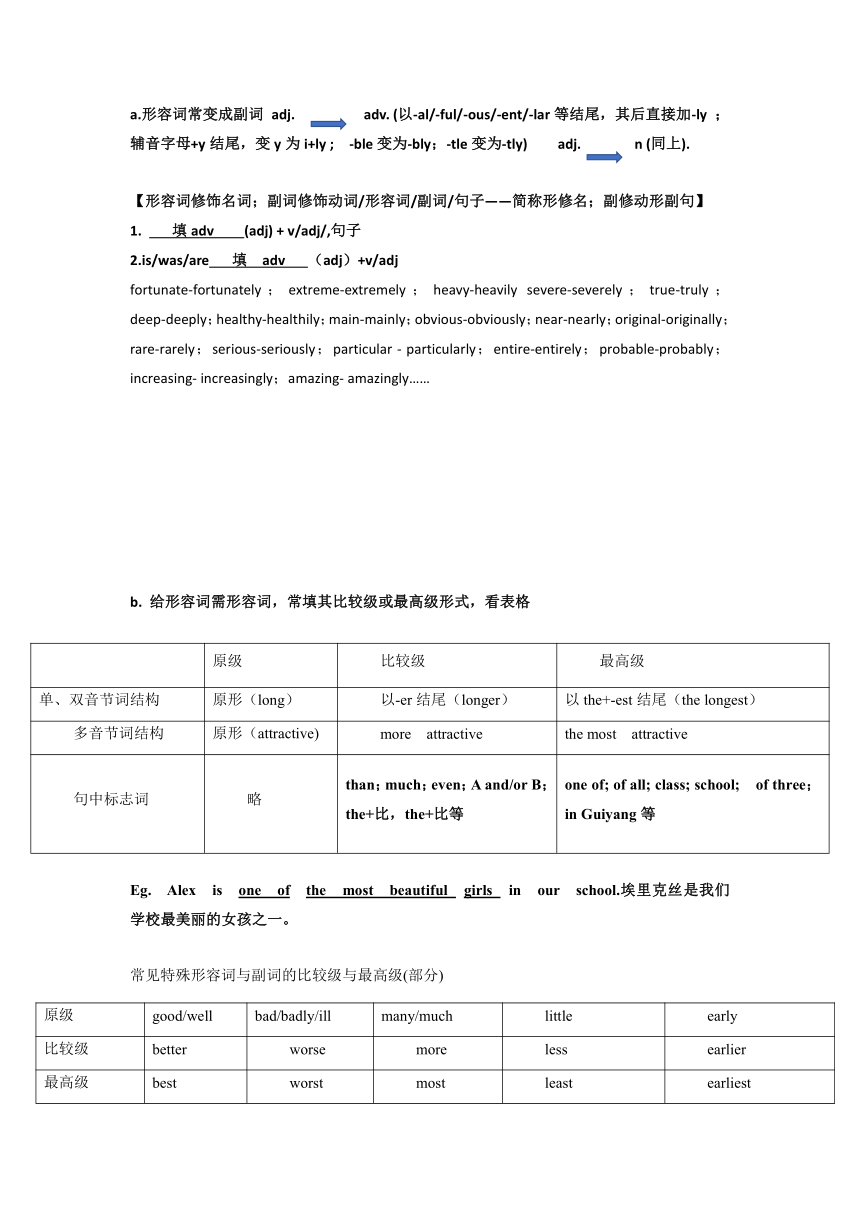
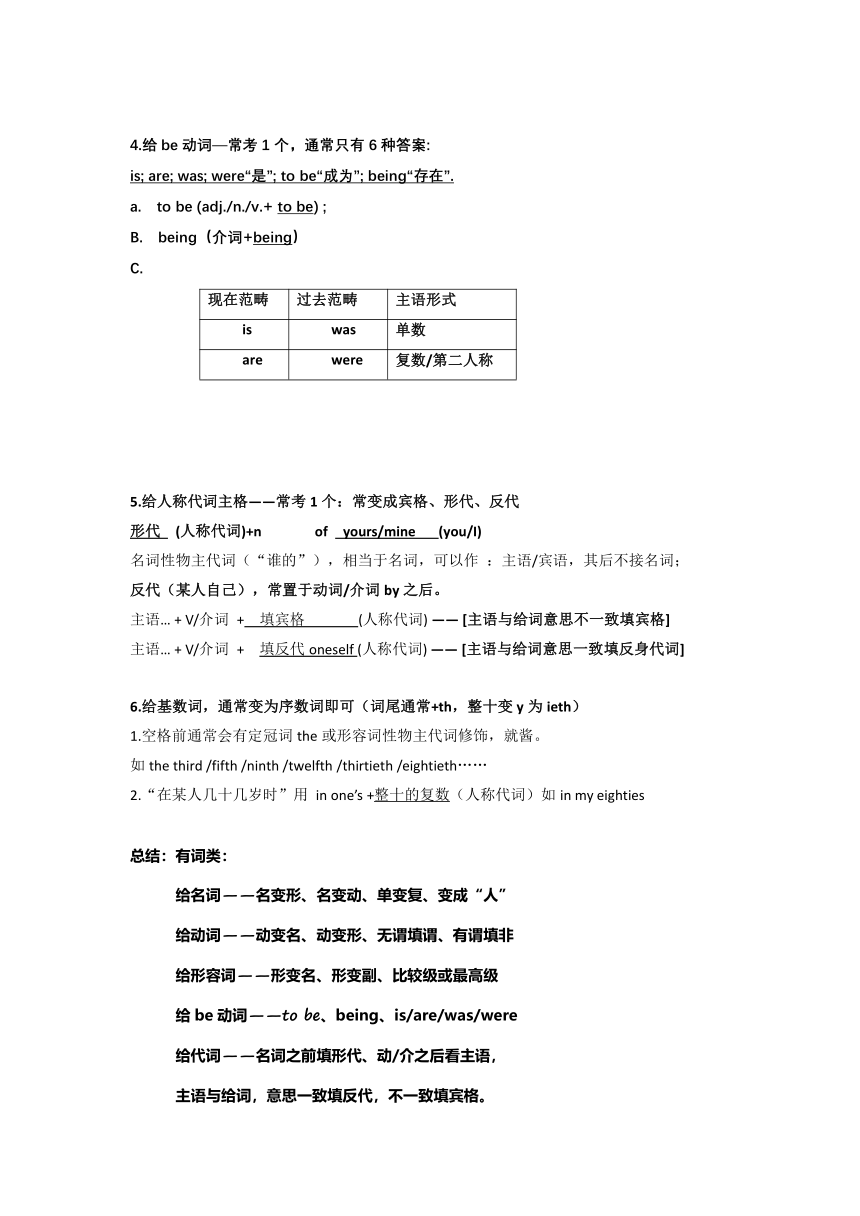
文档简介
语篇填空12分+技巧
有提示词常考虑改变词性或变换形式或填原形(极少);
无提示词常填代词it,冠词,连词,介词
建议做题步骤
第一遍先快速勾画空格前后确定本题所填的大方向词性,能确定答案则先提前填上;第二遍以句子为单位前后多读一点或通读本段确定具体形式。
检查是否有漏填或错填的,给动词题/形容词题可以填2个词左右之外,其余空格均仅填1词。
应对核心技巧——一定要背到溜溜熟
有提示词通常要变形(词性和形式)。注:名词n,动词v,形容词adj,副词adv;下同。
1.给名词n——常考1个:
名词变形常变成形容词。n. adj.(较多,如下) n. v.(较少,to do)
使用情况:
1. 填 adj + (n)+n ;
2. more/ the most+ 填adj (n)
3. 系动词(be动词/感官动词/变化动词get,turn,keep等)+ 填adj
variety-various多样的, consider-considerate考虑周到的,
consider - considerable大量的 evidence-evident明显的,recycle-recyclable可回收的
fortune-fortunate 幸运的, society-social社会的,benefit-beneficial有益的,
person-personal个人的, skill-skilled有技术的……
b.给名词需名词,常考单数变复数。1. adj+ n-s (n); 2. one of …+n-s (n); 3. 数词/介词短语+n-s (n);
few, two, all, several, different, kinds of, dozens of, hundreds of, a number of, one of …… +填名词复数(+s)
特别注意:给不可数名词填原形即可,如 luggage/buggage行李, equipment设备, newspaper报纸, experience体验,literature文学,furniture家具,grammar语法,vocabulary词汇,history历史,homework等等
给名词需名词,也常变成“人”,如she is a scientist (science) who studies animals.
与之对应的常考名词有act-actor/actress(女演员),write-writer,profess-professor教授……
2.给动词——必考5个左右:
a.动词变形常变成名词v. n.(如下) v. adj. (通常在词尾+ing/ ed;人-ed,物-ing,-ful等)
使用情况:
1.adj+ 填 n (v) —— 形修名
2. v+ 填n (v) —— 构成动宾结构“做啥”
3.(the)+ 填n (v)+of+ n / adj +n —— 构成A of B 结构 ,译为“B的A”
4.介词+ 填n或v-ing (v)
think-thought思想,invent-invention发明,prepare-preparation准备,consider-consideration考虑,celebrate-celebration庆祝,consume-consumer消费者,grow-growth,warm-warmth温暖,appreciate-appreciation感激,equip-equipment设备,travel-traveler旅行者及书信类别的动名词……
b.给动词需动词 常考谓语动词的时态与语态结构表
①以句子为单位,依据简单句“一句一谓动,其余动词作非谓语
(后宫定律:一帝一皇后,其余女人是妃子)”原则:
当本句无谓语动词时,本空填谓语动词。——简称“无谓填谓”
谓语动词的形式由时态、语态及主语人称决定。
时态看本句的时态标志词,如没有时态标志词,看上下句的谓语动词形式,此句与上下句时态保持一致;
语态有主被动之分:
主动:sb/sth+谓语动词,意为“某人/某物怎样了”;
被动:sb / sth+ be+ done “某人/某物被怎样了”。(done是过去分词,下同)
情态动词+ be +done(v)
常考谓语动词的时态与语态结构表
时态 主动结构 主谓之间是主动 被动结构“by...,被...”主谓之间是被动 时态标志词
一般过去时 动词过去式 was/were done ago, yesterday ,past, in 2011, last night/week/year..., just now, did…on…
一般现在时 动词原形或三单 am/is/are done every day(week, month, year...), often, always, usually, today, sometimes, in the morning等
一般将来时 Will do或 am/is/are going to do will be done future,next month/year..., in+时间段,tomorrow, some day, in 2078等
现在完成时 have/has done (及物动词的过去分词,上同) have/has been done since, already,recently, for+时间段, yet,lately,so far,in the past five years, in recent years, over the years, up to now/present, ever等
②以句子为单位,依据简单句“一句一谓动,其余动词作非谓语
(后宫定律:一帝一皇后,其余女人是妃子)”原则:
当本句有谓语动词时,本空填非谓语动词。——简称“有谓填非(谓)”
非谓语就是不能直接作谓语的动词,有不定式to do; 动名词doing 现在分词doing; 过去分词done
不定式to do(“去做”,表目的/将来) 如:want/decide/ it takes…to do等等;
be adj+ to do (v) ; be done+ to do (v) ;
It is adj (+for sb)+ to do (v) sth. v+ n+ to do (v)
动名词doing——常考固定用法 —— 如finish/ worth/ keep/介词+doing等等;
分词类常考:
Sb...…, doing (do)主语主动发出” ;
Sb...…, done (do)主语被动发出” 。
[本句有谓语时] :done +(v)+by… ; ——表被动:缺谓语,填be done;不缺谓语,填done.
[本句有谓语时] To do (v)……“为了…”——表目的
非谓语动词短语作后置定语也是热点考点。
[本句有谓语时] : ……+ n + doing/done (v)......——主动用doing“...的”;被动用done“被...的”
3.给形容词——必考1个:
a.形容词常变成副词 adj. adv. (以-al/-ful/-ous/-ent/-lar等结尾,其后直接加-ly ;辅音字母+y结尾,变y为i+ly ; -ble变为-bly;-tle变为-tly) adj. n (同上).
【形容词修饰名词;副词修饰动词/形容词/副词/句子——简称形修名;副修动形副句】
1. 填adv (adj) + v/adj/,句子
2.is/was/are 填 adv (adj)+v/adj
fortunate-fortunately;extreme-extremely;heavy-heavily severe-severely;true-truly;deep-deeply;healthy-healthily;main-mainly;obvious-obviously;near-nearly;original-originally;rare-rarely;serious-seriously;particular - particularly;entire-entirely;probable-probably;increasing- increasingly;amazing- amazingly……
原级 比较级 最高级
单、双音节词结构 原形(long) 以-er结尾(longer) 以the+-est结尾(the longest)
多音节词结构 原形(attractive) more attractive the most attractive
句中标志词 略 than;much;even;A and/or B; the+比,the+比等 one of; of all; class; school; of three;in Guiyang等
b. 给形容词需形容词,常填其比较级或最高级形式,看表格
Eg. Alex is one of the most beautiful girls in our school.埃里克丝是我们学校最美丽的女孩之一。
常见特殊形容词与副词的比较级与最高级(部分)
原级 good/well bad/badly/ill many/much little early
比较级 better worse more less earlier
最高级 best worst most least earliest
4.给be动词—常考1个,通常只有6种答案:
is; are; was; were“是”; to be“成为”; being“存在”.
to be (adj./n./v.+ to be) ;
being(介词+being)
现在范畴 过去范畴 主语形式
is was 单数
are were 复数/第二人称
5.给人称代词主格——常考1个:常变成宾格、形代、反代
形代 (人称代词)+n of yours/mine (you/I)
名词性物主代词(“谁的”),相当于名词,可以作 :主语/宾语,其后不接名词;
反代(某人自己),常置于动词/介词by之后。
主语… + V/介词 + 填宾格 (人称代词) —— [主语与给词意思不一致填宾格]
主语… + V/介词 + 填反代oneself (人称代词) —— [主语与给词意思一致填反身代词]
6.给基数词,通常变为序数词即可(词尾通常+th,整十变y为ieth)
1.空格前通常会有定冠词the或形容词性物主代词修饰,就酱。
如the third /fifth /ninth /twelfth /thirtieth /eightieth……
2.“在某人几十几岁时”用 in one’s +整十的复数(人称代词)如in my eighties
总结:有词类:
给名词——名变形、名变动、单变复、变成“人”
给动词——动变名、动变形、无谓填谓、有谓填非
给形容词——形变名、形变副、比较级或最高级
给be动词——to be、being、is/are/was/were
给代词——名词之前填形代、动/介之后看主语,
主语与给词,意思一致填反代,不一致填宾格。
另:祈使句,填动原形;不可数,填名原形(虽然考得非常少,但是也需要注意)
特殊信号词: A……and B——A与B结构一致; A of B ——“B的A”,A与B常为名词。
无提示词类填——代词/冠词/连词/介词
1.代词要么不考,要么考it,常置于句首或动词/介词之后,用来指代上下文内容。
It is/was……that…… “正是……” It is the first time that……
It is adj (for sb) to do sth. It is adj (for sb) that……
2.冠词——常考1个:
不定冠词a/an表示“一……”;
a+辅音音素开头的词,如a university/useful book… ;
an+以元音音素开头的词,如an hour/honor/honest boy/apple……;
an +a-/i-/o-开头的n/adj词 ; a + 辅音字母开头的词; 介词+the +n;
定冠词the表示特指“这…,那…”;常置于序数词/形副最高级/西洋乐器/形容词/名词之前,动词/介词之后。
常考固定搭配如the third/best/piano…,a sense of…,kind of a huge…,
the only…,an honorable…,in the long term…,
such a/an+名词…, a/an/the+adj/n…,
an effect/influence/expression of…, a burden to…,
a touch of…,all of a sudden…,
on the contrary…,an over 60%...,in the middle of…,follow the trend……
3.介词常考固定搭配——必考1个:
如more available than…,too…to…,from…to…,lack of, be known for,
be done by …, regard as ,see…as…,be known as…;
millions of, belong to, in+语言,stress on, be opposed to,
divided…into…,access to=next to=close to…,get rid of…,stop…from…,
based on…,in trouble/need…;spend…on…,pay…for…,
be sick of…,go on vacation…,for the first time, sounds like,
4.连词常考and/but/or/so/than以及从句的引导词(尤其是定语从句的引导词,下面重点讲) —必考1~2个
1. and表示并列,常考A and B “和/并且/然后”
but表示转折,常考A , but B “但是”
not…, but…不是…而是… not only…but also…不仅…而且… both……and……两者都 either…or…
形容词比较级……than… between…and…在…和…之间 neither…nor…既不...也不... 要么...要么...
2. 定语从句的引导词分为关系代词(who/which/that/whose/whom)和关系副词(when/where/why)
定语从句的引导词由其在从句中是否缺主语或宾语以及先行词决定。常考缺主语的一类:
看这个伟大表格【得意】
空格之后是动词 用关系代词 先行词指代对象 引导词的选择 从句与先行词的关系
从句缺主语(限制性从句) 用关系代词 人 who/that不译 关系紧密,从句修饰限定先行词 例:Wang Yuan is a handsome boy who comes from ChongQing.
用关系代词 物 which/tha不译
用关系代词 人and物 that 不译
从句缺主语(非限制性从句) 用关系代词 人 , who “他” 关系不紧密,从句补充说明先行词 例:Confucious is a great scholar,who lived from roughly 551 to 479 B.C.
用关系代词 物 , which“这”
注:1. A的B(A为名词或代词,B为名词时) 用whose. 例:There is an artist whose paintings are almost lifelike. 2. 先行词是only/something等复合不定代词/形容词最高级/序数词及被这些词修饰时,引导词用that
空格之后是主语 用关系副词 先行词指代对象 引导词的选择 从句与先行词的关系
从句不缺主语 用关系副词 时间(,) when 限制性定语从句:先行词与引导词之间无逗号隔开,关系紧密,从句用来修饰限定先行词; 非限制性定语从句:先行词与引导词之间有逗号隔开;关系不紧密,从句用来补充说明先行词。
用关系副词 地点(,) where
用关系副词 原因/理由 reason why
日常积累(2022预测)
be likely to do可能去做 be supposed to do应该去做
be able to concentrate能够集中 can’t stand to do不能忍受去做
Feel like doing想要做 介词of/for/about...+doing
kept doing继续做 couldn’t help doing情不自禁做
Would rather do...than do... 宁愿做 Make sb do You’d better do最好做
To my surprise,令我惊讶的是 The warmth温暖
Be located in位于 Lie in是
An increasing amount上升的数量 increasingly rise日益增加
As an example作为一个榜样 To their own对于他们自己
More appealing更有吸引力的 Higher risk of 更高的风险
Study examination研究检测
An impression of一个..的印象 An impressive person一个印象深刻的人
Recently...has drawn to... 最近...已经引起... compare with对比 has a great influence on有大影响
frequently do频繁做 speak English fluently流利地说英语
The amazing trip令人惊讶的旅行 sincere appreciation真诚的感谢
think--thoughts思想 was caught (catch)被抓住
Are described by...被描述... its hiding (hide) place它的藏身之处
...n that v... ..., in which... ..., which+v...
When+句子 介词 the 名词 ...,but+句子
In a word,简而言之 a number of +复数名词 许多。。。
ashamed and annoyed羞愧和愤怒 spoke highly of 高度评价
How/what/when to wear the truth真相
truly believe真正信任 randomly chosen随机选择
Joy--joyful高兴的 cheer--cheerful振奋的 color--colorful 多彩的
Benefit--beneficial受益的 origin--original原始的 spirit--spiritual精神的
Organ--organic有机的 science-scientific科学至上的
Adapt--adaptable适应的 adjust--adjustable/adjustment调整(的)
achieve--achievable/achievement成就(的) Notice--noticeable明显的
reason--reasonable合理的 flex--flexible灵活的 variety--various多样的
Frighten-frightening/-ed惊恐的 juice--juicy多汁的 taste--tasty美味的
tire-tiresome疲劳 trouble--troublesome麻烦
Random--randomly随意地 fierce--fiercely剧烈地
probable--probably可能地 healthy--healthily健康地
Responsible--Responsibly--responsibility责任 specific--specifically具体地
economic--economically经济地 true--truly真正地 day--daily日常的
Apply--application申请 appreciate--appreciation感激 repeat--repetition重复
found--foundation基业 Divide--division分离 describe--description描述
occupy--occupation占有 satisfy--satisfaction满足 Solve--solution解决
manage--management管理 adjust--adjustment调整 attend--attendance出席
Member--membership会员 short --shortage缺乏 civil--civilian市民
Absent--absence缺乏 His clients(client) 他的客户
take application into consideration把申请纳入考虑
第二节 (共10小题;每小题1.5分,满分15分)
阅读下面短文,在空白处填入1个适当的单词或括号内单词的正确形式。
Diets have changed in China and so too has its top crop. Since 2011, the country 61 (grow) more corn than rice. Corn production has jumped nearly 125 percent over 62 past 25 years, while rice has increased only 7 percent.
A taste for meat is 63 (actual) behind the change: An important part of its corn is used to feed chickens, pigs, and cattle. Another reason for corn’s rise: The government encourages farmers to grow corn instead of rice 64 (improve) water quality. Corn uses less water 65 rice and creates less fertilizer (化肥) runoff. This switch has decreased 66 (pollute) in the country’s major lakes and reservoirs and made drinking water safer for people.
According to the World Bank, China accounts for about 30 percent of total 67 (globe) fertilizer consumption. The Chinese Ministry of Agriculture finds that between 2005-when the government 68 (start) a soil-testing program 69 gives specific fertilizer recommendations to farmers - and 2011, fertilizer use dropped by 7.7 million tons. That prevented the emission(排放)of 51.8 million tons of carbon dioxide. China’s approach to protecting its environment while 70 (feed) its citizens “offers useful lessons for agriculture and food policymakers worldwide,” says the bank’s Juergen Voegele.
第二节 (共10小题;每小题1.5分,满分15分)
阅读下面短文,在空白处填入1个适当的单词或括号内单词的正确形式。
On our way to the house,it was raining 61 hard that we couldn't help wondering how long it would take 62 (get)there. It was in the middle of Pearl City.
We were first greeted with the barking by a pack 63 dogs,seven to be exact. They were well trained by their masters 64 had great experience with caring for these animals. Our hosts shared many of their experiences and 65 (recommend)wonderful places to eat,shop,and visit. For breakfast,we were able to eat papaya(木瓜)and other fruits from their trees in the backyard.
When they were free from work,they invited us to local events and let us know of an interesting 66 (compete)to watch,together with the story behind it. They also shared with us many 67 (tradition)stories about Hawaii that were 68 (huge)popular with tourists. On the last day of our week-long stay,we 69 (invite)to attend a private concert on a beautiful farm on the North Shore under the stars, 70 (listen)to musicians and meeting interesting locals.
有提示词常考虑改变词性或变换形式或填原形(极少);
无提示词常填代词it,冠词,连词,介词
建议做题步骤
第一遍先快速勾画空格前后确定本题所填的大方向词性,能确定答案则先提前填上;第二遍以句子为单位前后多读一点或通读本段确定具体形式。
检查是否有漏填或错填的,给动词题/形容词题可以填2个词左右之外,其余空格均仅填1词。
应对核心技巧——一定要背到溜溜熟
有提示词通常要变形(词性和形式)。注:名词n,动词v,形容词adj,副词adv;下同。
1.给名词n——常考1个:
名词变形常变成形容词。n. adj.(较多,如下) n. v.(较少,to do)
使用情况:
1. 填 adj + (n)+n ;
2. more/ the most+ 填adj (n)
3. 系动词(be动词/感官动词/变化动词get,turn,keep等)+ 填adj
variety-various多样的, consider-considerate考虑周到的,
consider - considerable大量的 evidence-evident明显的,recycle-recyclable可回收的
fortune-fortunate 幸运的, society-social社会的,benefit-beneficial有益的,
person-personal个人的, skill-skilled有技术的……
b.给名词需名词,常考单数变复数。1. adj+ n-s (n); 2. one of …+n-s (n); 3. 数词/介词短语+n-s (n);
few, two, all, several, different, kinds of, dozens of, hundreds of, a number of, one of …… +填名词复数(+s)
特别注意:给不可数名词填原形即可,如 luggage/buggage行李, equipment设备, newspaper报纸, experience体验,literature文学,furniture家具,grammar语法,vocabulary词汇,history历史,homework等等
给名词需名词,也常变成“人”,如she is a scientist (science) who studies animals.
与之对应的常考名词有act-actor/actress(女演员),write-writer,profess-professor教授……
2.给动词——必考5个左右:
a.动词变形常变成名词v. n.(如下) v. adj. (通常在词尾+ing/ ed;人-ed,物-ing,-ful等)
使用情况:
1.adj+ 填 n (v) —— 形修名
2. v+ 填n (v) —— 构成动宾结构“做啥”
3.(the)+ 填n (v)+of+ n / adj +n —— 构成A of B 结构 ,译为“B的A”
4.介词+ 填n或v-ing (v)
think-thought思想,invent-invention发明,prepare-preparation准备,consider-consideration考虑,celebrate-celebration庆祝,consume-consumer消费者,grow-growth,warm-warmth温暖,appreciate-appreciation感激,equip-equipment设备,travel-traveler旅行者及书信类别的动名词……
b.给动词需动词 常考谓语动词的时态与语态结构表
①以句子为单位,依据简单句“一句一谓动,其余动词作非谓语
(后宫定律:一帝一皇后,其余女人是妃子)”原则:
当本句无谓语动词时,本空填谓语动词。——简称“无谓填谓”
谓语动词的形式由时态、语态及主语人称决定。
时态看本句的时态标志词,如没有时态标志词,看上下句的谓语动词形式,此句与上下句时态保持一致;
语态有主被动之分:
主动:sb/sth+谓语动词,意为“某人/某物怎样了”;
被动:sb / sth+ be+ done “某人/某物被怎样了”。(done是过去分词,下同)
情态动词+ be +done(v)
常考谓语动词的时态与语态结构表
时态 主动结构 主谓之间是主动 被动结构“by...,被...”主谓之间是被动 时态标志词
一般过去时 动词过去式 was/were done ago, yesterday ,past, in 2011, last night/week/year..., just now, did…on…
一般现在时 动词原形或三单 am/is/are done every day(week, month, year...), often, always, usually, today, sometimes, in the morning等
一般将来时 Will do或 am/is/are going to do will be done future,next month/year..., in+时间段,tomorrow, some day, in 2078等
现在完成时 have/has done (及物动词的过去分词,上同) have/has been done since, already,recently, for+时间段, yet,lately,so far,in the past five years, in recent years, over the years, up to now/present, ever等
②以句子为单位,依据简单句“一句一谓动,其余动词作非谓语
(后宫定律:一帝一皇后,其余女人是妃子)”原则:
当本句有谓语动词时,本空填非谓语动词。——简称“有谓填非(谓)”
非谓语就是不能直接作谓语的动词,有不定式to do; 动名词doing 现在分词doing; 过去分词done
不定式to do(“去做”,表目的/将来) 如:want/decide/ it takes…to do等等;
be adj+ to do (v) ; be done+ to do (v) ;
It is adj (+for sb)+ to do (v) sth. v+ n+ to do (v)
动名词doing——常考固定用法 —— 如finish/ worth/ keep/介词+doing等等;
分词类常考:
Sb...…, doing (do)主语主动发出” ;
Sb...…, done (do)主语被动发出” 。
[本句有谓语时] :done +(v)+by… ; ——表被动:缺谓语,填be done;不缺谓语,填done.
[本句有谓语时] To do (v)……“为了…”——表目的
非谓语动词短语作后置定语也是热点考点。
[本句有谓语时] : ……+ n + doing/done (v)......——主动用doing“...的”;被动用done“被...的”
3.给形容词——必考1个:
a.形容词常变成副词 adj. adv. (以-al/-ful/-ous/-ent/-lar等结尾,其后直接加-ly ;辅音字母+y结尾,变y为i+ly ; -ble变为-bly;-tle变为-tly) adj. n (同上).
【形容词修饰名词;副词修饰动词/形容词/副词/句子——简称形修名;副修动形副句】
1. 填adv (adj) + v/adj/,句子
2.is/was/are 填 adv (adj)+v/adj
fortunate-fortunately;extreme-extremely;heavy-heavily severe-severely;true-truly;deep-deeply;healthy-healthily;main-mainly;obvious-obviously;near-nearly;original-originally;rare-rarely;serious-seriously;particular - particularly;entire-entirely;probable-probably;increasing- increasingly;amazing- amazingly……
原级 比较级 最高级
单、双音节词结构 原形(long) 以-er结尾(longer) 以the+-est结尾(the longest)
多音节词结构 原形(attractive) more attractive the most attractive
句中标志词 略 than;much;even;A and/or B; the+比,the+比等 one of; of all; class; school; of three;in Guiyang等
b. 给形容词需形容词,常填其比较级或最高级形式,看表格
Eg. Alex is one of the most beautiful girls in our school.埃里克丝是我们学校最美丽的女孩之一。
常见特殊形容词与副词的比较级与最高级(部分)
原级 good/well bad/badly/ill many/much little early
比较级 better worse more less earlier
最高级 best worst most least earliest
4.给be动词—常考1个,通常只有6种答案:
is; are; was; were“是”; to be“成为”; being“存在”.
to be (adj./n./v.+ to be) ;
being(介词+being)
现在范畴 过去范畴 主语形式
is was 单数
are were 复数/第二人称
5.给人称代词主格——常考1个:常变成宾格、形代、反代
形代 (人称代词)+n of yours/mine (you/I)
名词性物主代词(“谁的”),相当于名词,可以作 :主语/宾语,其后不接名词;
反代(某人自己),常置于动词/介词by之后。
主语… + V/介词 + 填宾格 (人称代词) —— [主语与给词意思不一致填宾格]
主语… + V/介词 + 填反代oneself (人称代词) —— [主语与给词意思一致填反身代词]
6.给基数词,通常变为序数词即可(词尾通常+th,整十变y为ieth)
1.空格前通常会有定冠词the或形容词性物主代词修饰,就酱。
如the third /fifth /ninth /twelfth /thirtieth /eightieth……
2.“在某人几十几岁时”用 in one’s +整十的复数(人称代词)如in my eighties
总结:有词类:
给名词——名变形、名变动、单变复、变成“人”
给动词——动变名、动变形、无谓填谓、有谓填非
给形容词——形变名、形变副、比较级或最高级
给be动词——to be、being、is/are/was/were
给代词——名词之前填形代、动/介之后看主语,
主语与给词,意思一致填反代,不一致填宾格。
另:祈使句,填动原形;不可数,填名原形(虽然考得非常少,但是也需要注意)
特殊信号词: A……and B——A与B结构一致; A of B ——“B的A”,A与B常为名词。
无提示词类填——代词/冠词/连词/介词
1.代词要么不考,要么考it,常置于句首或动词/介词之后,用来指代上下文内容。
It is/was……that…… “正是……” It is the first time that……
It is adj (for sb) to do sth. It is adj (for sb) that……
2.冠词——常考1个:
不定冠词a/an表示“一……”;
a+辅音音素开头的词,如a university/useful book… ;
an+以元音音素开头的词,如an hour/honor/honest boy/apple……;
an +a-/i-/o-开头的n/adj词 ; a + 辅音字母开头的词; 介词+the +n;
定冠词the表示特指“这…,那…”;常置于序数词/形副最高级/西洋乐器/形容词/名词之前,动词/介词之后。
常考固定搭配如the third/best/piano…,a sense of…,kind of a huge…,
the only…,an honorable…,in the long term…,
such a/an+名词…, a/an/the+adj/n…,
an effect/influence/expression of…, a burden to…,
a touch of…,all of a sudden…,
on the contrary…,an over 60%...,in the middle of…,follow the trend……
3.介词常考固定搭配——必考1个:
如more available than…,too…to…,from…to…,lack of, be known for,
be done by …, regard as ,see…as…,be known as…;
millions of, belong to, in+语言,stress on, be opposed to,
divided…into…,access to=next to=close to…,get rid of…,stop…from…,
based on…,in trouble/need…;spend…on…,pay…for…,
be sick of…,go on vacation…,for the first time, sounds like,
4.连词常考and/but/or/so/than以及从句的引导词(尤其是定语从句的引导词,下面重点讲) —必考1~2个
1. and表示并列,常考A and B “和/并且/然后”
but表示转折,常考A , but B “但是”
not…, but…不是…而是… not only…but also…不仅…而且… both……and……两者都 either…or…
形容词比较级……than… between…and…在…和…之间 neither…nor…既不...也不... 要么...要么...
2. 定语从句的引导词分为关系代词(who/which/that/whose/whom)和关系副词(when/where/why)
定语从句的引导词由其在从句中是否缺主语或宾语以及先行词决定。常考缺主语的一类:
看这个伟大表格【得意】
空格之后是动词 用关系代词 先行词指代对象 引导词的选择 从句与先行词的关系
从句缺主语(限制性从句) 用关系代词 人 who/that不译 关系紧密,从句修饰限定先行词 例:Wang Yuan is a handsome boy who comes from ChongQing.
用关系代词 物 which/tha不译
用关系代词 人and物 that 不译
从句缺主语(非限制性从句) 用关系代词 人 , who “他” 关系不紧密,从句补充说明先行词 例:Confucious is a great scholar,who lived from roughly 551 to 479 B.C.
用关系代词 物 , which“这”
注:1. A的B(A为名词或代词,B为名词时) 用whose. 例:There is an artist whose paintings are almost lifelike. 2. 先行词是only/something等复合不定代词/形容词最高级/序数词及被这些词修饰时,引导词用that
空格之后是主语 用关系副词 先行词指代对象 引导词的选择 从句与先行词的关系
从句不缺主语 用关系副词 时间(,) when 限制性定语从句:先行词与引导词之间无逗号隔开,关系紧密,从句用来修饰限定先行词; 非限制性定语从句:先行词与引导词之间有逗号隔开;关系不紧密,从句用来补充说明先行词。
用关系副词 地点(,) where
用关系副词 原因/理由 reason why
日常积累(2022预测)
be likely to do可能去做 be supposed to do应该去做
be able to concentrate能够集中 can’t stand to do不能忍受去做
Feel like doing想要做 介词of/for/about...+doing
kept doing继续做 couldn’t help doing情不自禁做
Would rather do...than do... 宁愿做 Make sb do You’d better do最好做
To my surprise,令我惊讶的是 The warmth温暖
Be located in位于 Lie in是
An increasing amount上升的数量 increasingly rise日益增加
As an example作为一个榜样 To their own对于他们自己
More appealing更有吸引力的 Higher risk of 更高的风险
Study examination研究检测
An impression of一个..的印象 An impressive person一个印象深刻的人
Recently...has drawn to... 最近...已经引起... compare with对比 has a great influence on有大影响
frequently do频繁做 speak English fluently流利地说英语
The amazing trip令人惊讶的旅行 sincere appreciation真诚的感谢
think--thoughts思想 was caught (catch)被抓住
Are described by...被描述... its hiding (hide) place它的藏身之处
...n that v... ..., in which... ..., which+v...
When+句子 介词 the 名词 ...,but+句子
In a word,简而言之 a number of +复数名词 许多。。。
ashamed and annoyed羞愧和愤怒 spoke highly of 高度评价
How/what/when to wear the truth真相
truly believe真正信任 randomly chosen随机选择
Joy--joyful高兴的 cheer--cheerful振奋的 color--colorful 多彩的
Benefit--beneficial受益的 origin--original原始的 spirit--spiritual精神的
Organ--organic有机的 science-scientific科学至上的
Adapt--adaptable适应的 adjust--adjustable/adjustment调整(的)
achieve--achievable/achievement成就(的) Notice--noticeable明显的
reason--reasonable合理的 flex--flexible灵活的 variety--various多样的
Frighten-frightening/-ed惊恐的 juice--juicy多汁的 taste--tasty美味的
tire-tiresome疲劳 trouble--troublesome麻烦
Random--randomly随意地 fierce--fiercely剧烈地
probable--probably可能地 healthy--healthily健康地
Responsible--Responsibly--responsibility责任 specific--specifically具体地
economic--economically经济地 true--truly真正地 day--daily日常的
Apply--application申请 appreciate--appreciation感激 repeat--repetition重复
found--foundation基业 Divide--division分离 describe--description描述
occupy--occupation占有 satisfy--satisfaction满足 Solve--solution解决
manage--management管理 adjust--adjustment调整 attend--attendance出席
Member--membership会员 short --shortage缺乏 civil--civilian市民
Absent--absence缺乏 His clients(client) 他的客户
take application into consideration把申请纳入考虑
第二节 (共10小题;每小题1.5分,满分15分)
阅读下面短文,在空白处填入1个适当的单词或括号内单词的正确形式。
Diets have changed in China and so too has its top crop. Since 2011, the country 61 (grow) more corn than rice. Corn production has jumped nearly 125 percent over 62 past 25 years, while rice has increased only 7 percent.
A taste for meat is 63 (actual) behind the change: An important part of its corn is used to feed chickens, pigs, and cattle. Another reason for corn’s rise: The government encourages farmers to grow corn instead of rice 64 (improve) water quality. Corn uses less water 65 rice and creates less fertilizer (化肥) runoff. This switch has decreased 66 (pollute) in the country’s major lakes and reservoirs and made drinking water safer for people.
According to the World Bank, China accounts for about 30 percent of total 67 (globe) fertilizer consumption. The Chinese Ministry of Agriculture finds that between 2005-when the government 68 (start) a soil-testing program 69 gives specific fertilizer recommendations to farmers - and 2011, fertilizer use dropped by 7.7 million tons. That prevented the emission(排放)of 51.8 million tons of carbon dioxide. China’s approach to protecting its environment while 70 (feed) its citizens “offers useful lessons for agriculture and food policymakers worldwide,” says the bank’s Juergen Voegele.
第二节 (共10小题;每小题1.5分,满分15分)
阅读下面短文,在空白处填入1个适当的单词或括号内单词的正确形式。
On our way to the house,it was raining 61 hard that we couldn't help wondering how long it would take 62 (get)there. It was in the middle of Pearl City.
We were first greeted with the barking by a pack 63 dogs,seven to be exact. They were well trained by their masters 64 had great experience with caring for these animals. Our hosts shared many of their experiences and 65 (recommend)wonderful places to eat,shop,and visit. For breakfast,we were able to eat papaya(木瓜)and other fruits from their trees in the backyard.
When they were free from work,they invited us to local events and let us know of an interesting 66 (compete)to watch,together with the story behind it. They also shared with us many 67 (tradition)stories about Hawaii that were 68 (huge)popular with tourists. On the last day of our week-long stay,we 69 (invite)to attend a private concert on a beautiful farm on the North Shore under the stars, 70 (listen)to musicians and meeting interesting locals.
